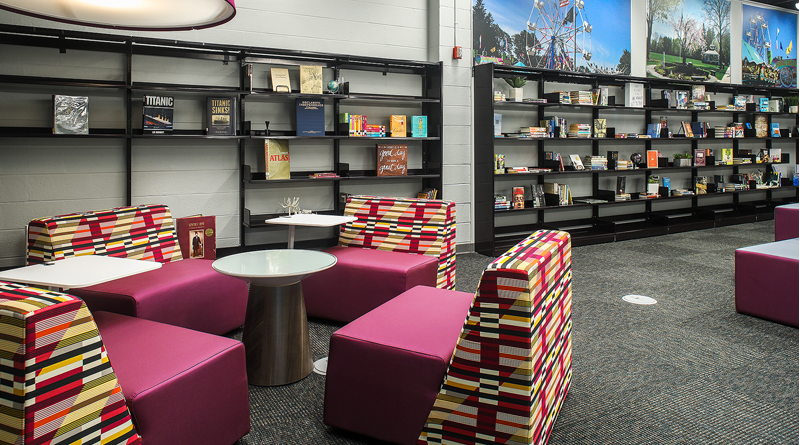New Classroom Furniture Styles Boost the Four Cs
By Maureen Tracy
For generations, educational curriculum has been based on the principles of reading, writing, and arithmetic. While these fundamentals remain, the emphasis in recent years has shifted to science, technology, engineering and math (STEM) to prepare today’s young learners for high-tech careers. School systems are also focused increasingly on the four C’s – critical thinking, communication, collaboration, and creativity – qualities that shape future contributions to the workplace and society as a whole.
These changes have led schools to adopt an integrated curriculum that moves away from a single instructor focused on a single subject, stationed at the front of the classroom, to a model designed to empower students to discover information on their own through creative problem solving and decision making. This approach, according to Education Week, removes the barriers that limit children and separate learning into content areas.
Clearly, these new styles of teaching and learning require new kinds of spaces to support them. Classroom furniture, for example, must be mobile, flexible, and adaptable to allow and encourage movement throughout the day. Mobility allows students to get up from their chairs, while empowering teachers to adjust the classroom configuration as they move through their daily lesson plans. By moving desks, chairs, tables, power sources, and even walls, teachers now have the flexibility for students to tackle individual assignments, work in small groups, or come together as a class to solve problems, often presented on an interactive white board at the front of the room.
Ancillary furniture (informal furniture and accessories that support a range of postures, including sitting, perching, lounging, and standing) also plays an important role in improving student engagement. Just as it is increasingly seen in office environments to support diverse working styles, ancillary furniture provides students with choices that help them feel more in control, while acknowledging the fact that students have different learning styles. Some prefer to sit by themselves, while others want to work in groups. Some want to sit upright at a traditional desk, while lounging is the preferred posture for others. Walking into a classroom and seeing a variety of comfortable, colorful furniture helps students to feel more engaged and, in turn, makes learning more fun and exciting.
This same approach applies to open spaces, where noise levels and speech privacy are often concerns. To support individuals looking for a quiet place to study or students trying to complete group projects, pods provide privacy and offer another learning option. Sound masking can also be incorporated in open collaboration areas, student hubs, and active learning classrooms to reduce noise transmission.
At the opposite end of the noise spectrum, the school library – traditionally the location for students to quietly immerse themselves in books and periodicals at private carrels or at shared tables where they scribble notes for homework or an upcoming book report – has evolved into a “learning common” where students and teachers at every level can gather and share knowledge. And because everyone learns differently, the library space must offer a variety of ways to use it.
Today’s learning commons should encourage active learning with comfortable and inviting spaces designed to cultivate student engagement and motivation. Students and teachers must be able to choose between different spaces and furnishings to accommodate their current task at hand, whether it requires heads-down focus, collaborative teamwork, or presentations to a group. And they need the flexibility to reconfigure the space or furnishings as their tasks change.
Just as in the classroom, flexible furniture throughout the library space helps students adapt to different group sizes and tasks. Ideally seating should allow for easy mobility for individual versus group work, and to provide different posture options to match a student’s study needs. Walls, white boards, and tables (many of which have built-in media screens and height-adjustable legs) must also be moveable to enable privacy and offer a choice of working with analog or digital tools.
Beyond flexible learning spaces, the integration of technology obviously plays a pivotal role in keeping students and teachers connected with each other and their peers. When applied properly, technology (computers, mobile devices, digital displays, etc.) can complement the curriculum by assisting students as they gather information and share content. Utilizing intuitive AV equipment, teachers can take advantage of video and audio conference systems to supplement instruction with recorded lessons and demonstrations. These collaborative tools also facilitate viewing a specific lesson multiple times or at a later time, encouraging students to become self-directed learners.
But what is technology without power? Distributing power throughout a space and providing all users with equal access to keep their devices connected is crucial in keeping students engaged. When students don’t have to search for a power source when they see the dying red battery symbol on their devices, they’re better able to stay focused on the lessons at hand. Whether it’s integrated Thread power solutions or Flex mobile power units that students can take with them, providing users with access to power encourages them to study and learn for longer periods.
Whole communities benefit from making schools, classrooms, and libraries more active and better connected. By investing in today’s students and giving them spaces that are better equipped for active learning, we can ensure that the academic and corporate sectors of our society advance in parallel, ultimately building a better workforce for the future.
Maureen Tracy is an Account Executive at dancker (www.dancker.com), a leading interior solutions company that fully integrates architectural, furniture, and technology solutions as a one-source provider and logistics manager for corporate, education and healthcare facilities.

